“It Changed and Changed and Changed and Changed”: How Sundance 2021 Pulled off Its Virtual Festival
Photos Courtesy of Sundance Institute
How does one of the world’s most iconic film festivals condense down into a neat digital package during the COVID-19 pandemic, without losing the experiential details that make the festival what it is in the first place? Nonstop planning, nonstop talking (via computer, so as to not spread droplets) and, yes, a little bit of luck—such as anyone could call the folks running the 2021 Sundance Film Festival “lucky” for having time and the long view on their side when planning this year’s iteration. Yes, lucky! How lucky indeed, to have your massive filmmaking industry event fall on the calendar after nearly a year of life under COVID, with so many other festivals in your wake having chosen to cancel! That’s the kind of luck you get from talking to a monkey’s paw.
2020 being the trash fire it was, and with 2021 proudly carrying that conflagration forward for the first days of its wretched lifespan, any turn of fate that even somewhat resembles “luck” is nothing to sneeze at, though maybe we should find a better word as it applies to Sundance ‘21. “I want to reframe it slightly,” said Tabitha Jackson, who took the job as Sundance Film Festival director last year after serving the Sundance Institute as director of the documentary film program for six years. “I think, yes, we were incredibly lucky that we were able to put on the full manifestation of Sundance.” Especially, she adds, since it was her predecessor John Cooper’s last year. At the same time, there lingered feelings of compassion and sadness for colleagues running festivals like Tribeca and SXSW, who—faced with much tighter timelines—couldn’t react and adapt to COVID in 2020 and had to shutter for the year.
Pulling off Sundance in 2021 with 2020 looming in the rearview meant dealing with complicated feelings, but the programmers charged with launching the 2021 festival had, after all, a whole year to figure out a solution to the coronavirus problem. Sort of. “It didn’t feel like we had a year,” Jackson pointed out. “Throughout the whole thing and right through the uprising for racial justice, the numbers changed all the time. Pretty much the last thing we did was cancel 70 drive-ins that we thought would happen in L.A. because we thought L.A. would, for some reason, be a better place to do it. And we had to cancel. So we never, ever had any firm ground upon which to plan.”
Charlie Reff Sextro, one of Sundance’s programmers, adds buttressing corroborative detail to Jackson’s chronicle of Sundance ‘21’s journey from a shrug emoji to a live event unfolding on folks’ screens—large and small—at home. “We started planning this year’s festival in the first weeks of April of last year, and so it changed a lot,” Sextro said. “After asking questions, and talking, and after the things that we explored, it changed and changed and changed and changed.”
It’s striking that both he and Jackson describe Sundance ‘21 in terms of evolution, as if the festival is a living, breathing entity, because ultimately that’s what it turned out to be. This was not an on-demand content drip. For Jackson, for Sextro, for the many other programmers and coordinators, this was about making a filmmaker experience, an audience experience and a collective space where those experiences collide.
Frankly, thinking back on the particulars of watching a film live, Sundance did make a convincing surrogate for an in-person festival this year: First, audience members would go into a waiting room with a chat function, where they could confab with one another ahead of the start time. Then, after each and every feature, the programmers would conduct live Q&As with the talent. Jackson fondly recalled the “perverse glee” she felt over how nervous filmmakers would get while sitting on-deck for post-screening conversation, because “it meant that it was a moment.” In fact, the more Sextro and Jackson talk about these online screenings, the more that the “online” part loses significance. “I’ve gone away from even describing what we’re doing as a virtual festival,” said Jackson. “It was a festival. It was a festival with real feelings, real work, real experiences, real encounters.”
-

-

-

-

-

-

-

-

-

-

-

-

-

-

-

-

-

-

-

-

-

-

-

-

-

-

-

-

-

-

-

-

-

-

-

-

-

-

-

-








































